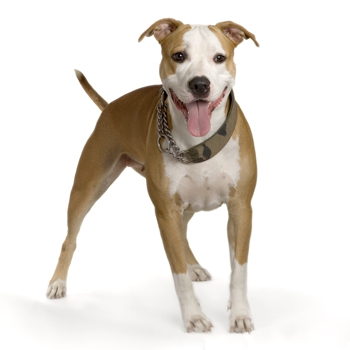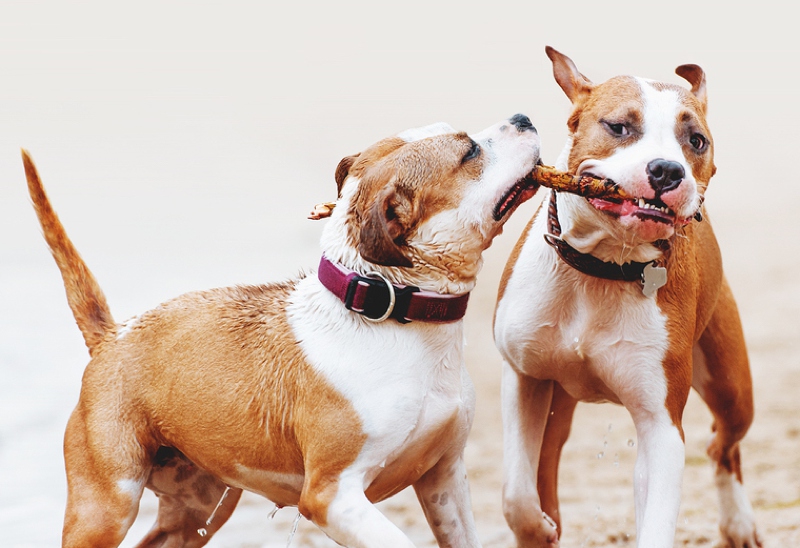American Staffordshire Terrier

Developed within the last 200 years, the American Staffordshire Terrier is a mix of the Bulldog and several Terrier breeds. Traditionally used in dog fighting, this breed has come a long way from its nefarious beginnings and is now more often spotted within the family home, cuddled up close with its master. Remarkably loyal, this breed will put its owner above everyone else; including itself.
Stocky and powerful, the medium-sized American Staffordshire Terrier should be well put-together. Their coat is short and may be any colour. Nowadays, natural ears and tails are much preferred to the old-fashioned cropped ears and docked tails that they once sported.
About & History
A Bull Terrier type breed, the American Staffordshire Terrier is commonly referred to by those in the know as the AmStaff. Their story begins in England, in the mid 19th century, when their ancestors, the Bulldog and a variety of Terriers, were frequently used in dog fights in the UK. While the terriers were fierce and brave, they lacked stature and bulk; traits which the Bulldogs of the time had in spades.
Almost inevitably, these two breeds were mixed together, resulting in a breed known at the time as a Bull and Terrier. Overtime, this dog developed into the Bull Terrier; renowned for its speed, strength and canine aggression. The Bull Terrier then evolved into two separate breeds: The modern-day Bull Terrier and the Staffordshire Bull Terrier. At the end of the 19th century, Staffordshire Terriers were exported to the USA.
While some were used for dog fighting, many others were employed as farm dogs and boar hunters. The American versions of this breed was bred to be larger and heavier than their British cousins. The AKC recognises the American Staffordshire Terrier and the Staffordshire Bull Terrier as two distinct breeds, and initially accepted the AmStaff into their books in 1936.
Over the years, the American Staffordshire Terrier has been bred to have a large and powerful head with an impressive jaw, ensuring it is physically distinct from the English Staffordshire Bull Terrier. When it comes to their character, those with a high pain threshold and gritty determination have always been favoured. While initially dogs would have been bred for their aggression towards other dogs, with the outlawing of dog fighting, this is no longer the case.
Nowadays, many American states and European countries have banned the American Staffordshire Terrier, though this has proven to be a law that is almost impossible to enforce, with many people owning the ‘banned’ breed and suffering no consequences. It is undeniable that they come with a ‘label’ and are often owned by criminals and thugs who take advantage of their loyalty and protective nature, training them to become overly aggressive. Sadly, being a breed that is favoured by unsavoury characters, shelters and rescue centres often have a high number of American Staffordshire Terriers searching for their forever homes thanks to a poor start in life. The adage holds true for the American Staffordshire Terrier: There’s no such thing as a bad breed, just a bad owner.
Initially used as fighting dogs and then as farm hands, today, this breed may be seen working for the police force or employed as watch and guard dogs. Their attractive qualities stretch far beyond their working abilities though, as this is a dog that is known to make a loving and affectionate family pet. As American Staffordshire Terriers are registered under a variety of organisations, it is difficult to know for sure how many of them currently exist. Within America, they are undeniably one of the more popular dog breeds.
Appearance

A sturdy and heavily muscled dog, the American Staffordshire Terrier certainly gives off an intimidating first impression. Their wide head possesses an obvious stop, strong jaw and well-developed cheek muscles. They have dark, circular eyes that should not be too close together. Many breed members will have cropped ears, though this is falling out of favour and natural, short ears are preferred.
Their nose must be black in colour. Their thick neck should have no dewlap of skin and should flow smoothly into their wide shoulders. They have a short back that gently slopes, a wide chest and well-sprung ribs. Their tail must not be overly long and should taper out to a point. Despite their bulk, they should retain a graceful gait.
Their short, shiny coat is harsh to the touch. While any coat colour is permissible, white, liver or black and tans coats are discouraged. Females stand between 43cm and 46cm, while the larger male reaches heights of 48cm. A typical dog weighs from 18kg to 27kg.
Character & Temperament
A dedicated companion, American Staffordshire Terriers are people-oriented and protective of those they love. Brave and confident, they are full of life and have big hearts. Their intelligence makes them relatively easy to train; sadly, a trait that has been manipulated by humans to some breed members’ detriment.
Once properly supervised and adequately socialised from young, the American Staffordshire Terrier can make a good friend to children. As with any dogs, they do not have endless patience and children must be taught how to respect dogs as animals.
Both as a watch dog and a guard dog, this breed excels, enjoying being given a task to carry out and happy to please their master. Not one to rest when working, they constantly pay attention to their surroundings, checking for any suspicious activity and reacting instantly.
Trainability

Very easily trained, this eager to please dog is smart enough to perform well in most canine disciplines. This has ensured their place as police dogs and in search and rescue missions. It has also historically earned them respect on farm yards, where their trainability allowed them to become versatile farm hands.
The American Staffordshire Terrier benefits from a confident master who has experience in what they are doing and is firm and clear in their instruction. Negative reinforcement or punishment style behaviours should be avoided at all costs, as they can lead to resentment and an unhappy dog.
Health
The American Staffordshire Terrier will usually live to the age of around 12 years old and tends to enjoy good health. A few conditions to be aware of would include:
Hip and Elbow Dysplasia
The hip joints and elbow joints are essential for good mobility but are often far from perfectly formed in many purebred dogs. Signs may be subtle or screamingly obvious, depending on the extent of the joint disease.
Given the genetic component, it is vital that breeding dogs have their elbows and hips screened and that potential buyers act responsibly and request that these tests be carried out.
Hypothyroidism
An underactive thyroid can result in a variety of vague symptoms, including weight gain, sluggishness and recurrent skin infections. This endocrine disease can be difficult to diagnose, as false positive results occur commonly in unwell dogs. Once diagnosed, this condition is treated with daily oral medication, to which the response tends to be good.
Adult‐Onset Cerebellar Cortical Degeneration
This is a rare neurological disease that has been studied within the breed. Symptoms can include wobbliness, goose-stepping and muscle tremors. Dogs will act mentally as if nothing is wrong. The condition may be suspected if a small cerebellum is seen on an MRI scan but can only be definitively diagnosed on a necropsy. There is no cure and treatment is supportive. A genetic test is now available for this disease in some countries.
Exercise and Activity Levels
This is a dog that can adapt well to living inside a small home once provided with enough exercise. They like the opportunity to roam their territory in a gated garden and also enjoy being taken outside on walks and hikes. They should not be allowed off-lead in public (unless very well trained and socialised) due to the risk of canine to canine aggression and the potential for them to seriously injure other dogs, particularly small ones.
The American Staffordshire Terrier loves long and interactive play sessions with its family and should be given the opportunity to show off its intelligence solving puzzles and participating in agility and obedience. It would not be sufficient for an owner to simply leave their AmStaff in the garden all day, as they will likely become bored and frustrated.
Grooming
A soft brush can be used to distribute their natural oils along their coat once weekly, but further grooming is not really required. While their ears are not prone to infections, they should be kept clean and dry. Claws may need trimming from time to time, particularly if the dog is restricted to soft, grassy land and not walked on pavement or roads.
Famous American Staffordshire Terriers
Pete the Pup was an AmStaff that starred in the 1930s series of movies Our Gang. The dog who played Pete was called ‘Pal the Wonder Dog’ in real life. Interestingly, ‘Pal’ had a distinctive dark ring of fur around his eye that had to be drawn-in on replacement canine actors with make-up after he passed away.
Sergeant Stubby is a decorated American war hero from the 1920s. It is unsure whether he was an American Staffordshire Terrier or a Bull Terrier. His obituary features in the New York Times and he even has his own inscribed brick at the Liberty Memorial.
Cross-Breeds
The American Staffordshire Terrier is itself a mix of the Bull Terrier and Bulldog.
In terms of cross breeds involving the American Staffordshire Terrier, there are plenty of them, including (but certainly not limited to):
- American Bull Staffy – Cross between an American Staffordshire Terrier and an American Bulldog
- Amstiff – Cross between an American Staffordshire Terrier and a Mastiff
- Bullboxer – Cross between an American Staffordshire Terrier and a Boxer
- Frenchie Staff – Cross between an American Staffordshire Terrier and a French Bulldog
- Labrastaff – Cross between an American Staffordshire Terrier and a Labrador
- Canis Panther – Cross between an American Staffordshire Terrier, a Great Dane, a Doberman and a Labrador Retriever

